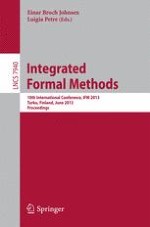This book constitutes the refereed proceedings of the 10th International Conference on Integrated Formal Methods, IFM 2013, held in Turku, Finland, in June 2013.
The 25 revised full papers presented together with 4 invited papers were carefully reviewed and selected from 84 full paper submissions. The papers cover the spectrum of integrated formal methods, focusing on refinement, integration, translation, verification, reachability and model checking, usability and testing, distributed systems, semantics, and system-level analysis.
